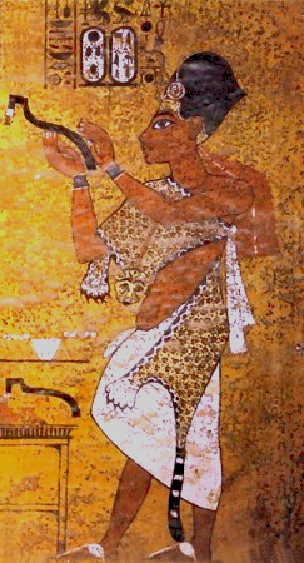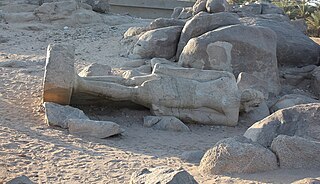Related Research Articles

Amenhotep III, also known as Amenhotep the Magnificent or Amenhotep the Great, was the ninth pharaoh of the Eighteenth Dynasty. According to different authors, he ruled Egypt from June 1386 to 1349 BC, or from June 1388 BC to December 1351 BC/1350 BC, after his father Thutmose IV died. Amenhotep was Thutmose's son by a minor wife, Mutemwiya.
Thutmose is an Anglicization of the Ancient Egyptian personal name dhwty-ms, usually translated as "Born of the god Thoth".

Ay was the penultimate pharaoh of ancient Egypt's 18th Dynasty. He held the throne of Egypt for a brief four-year period in the late 14th century BC. Prior to his rule, he was a close advisor to two, and perhaps three, other pharaohs of the dynasty. It is speculated that he was the power behind the throne during child ruler Tutankhamun's reign. His prenomenKheperkheperure means "Everlasting are the Manifestations of Ra," while his nomenAy it-netjer reads as "Ay, Father of the God." Records and monuments that can be clearly attributed to Ay are rare, both because his reign was short and because his successor, Horemheb, instigated a campaign of damnatio memoriae against him and the other pharaohs associated with the unpopular Amarna Period.

Menpehtyre Ramesses I was the founding pharaoh of ancient Egypt's 19th Dynasty. The dates for his short reign are not completely known but the time-line of late 1292–1290 BC is frequently cited as well as 1295–1294 BC. While Ramesses I was the founder of the 19th Dynasty, his brief reign mainly serves to mark the transition between the reign of Horemheb, who had stabilized Egypt in the late 18th Dynasty, and the rule of the powerful pharaohs of his own dynasty, in particular his son Seti I, and grandson Ramesses II.
Ahmose called Turo was Viceroy of Kush under Amenhotep I and Thutmose I.

Merymose, also Mermose or Merimes, was a Viceroy of Kush under Amenhotep III. He served for almost the entire four decades of that reign.

Amenemopet served as Viceroy of Kush during the reign of Seti I.
Heqanakht was Viceroy of Kush during the reign of Ramesses II. His titles include: King's son of Kush, overseer of the Southern Lands, Fan-bearer on the Right Side of the King, Messenger to every land, Hereditary prince, royal sealbearer.
in Ancient Egypt, Paser II was the son of the High Priest of Min and Isis named Minmose. Paser came from a very well-connected family. One uncle was the High Priest of Amun Wennenefer and another uncle was the troop commander of Kush named Pennesuttawy. Through Wennenefer, Paser was related to Amenemone, Amenemope and Hori, the High Priest of Anhur.
Huy was Viceroy of Kush during the reign of Ramesses II. He may have served either before or after Setau. Huy was also Mayor of Tjarw and a royal messenger to the Hatti.
Paser I was the Viceroy of Kush during the reigns of Ay and likely Horemheb. Reisner mentions that the only datable inscriptions for Paser belong to the reign of Ay. The next known Viceroy however is Amenemopet, who is dated to the reign of Seti I. Hence it's possible that Paser I served during the reigns of Ay, Horemheb.

The Viceroy of Kush Seti is attested in year 1 of Siptah. Seti is also mentioned on some monuments of his son Amenemhab. Amenemhab was the son of Seti and the Lady Amenemtaiauw. Seti held the titles fan-bearer on the king's right, and king's scribe of the letters of the Pharaoh. His son Amenemheb served as Head Bowman, Charioteer of His Majesty, and Overseer of the Southern Lands.
Hori II is a son of Hori I and also served as Viceroy of Kush. Their tombs have been found in Tell Basta. Hori II may have been the father of a later Viceroy named Wentawat.

Wentawat, was Viceroy of Kush under Ramesses IX, during the 20th Dynasty. He was a son of the Viceroy Nahihor.
This page list topics related to ancient Egypt.

The Theban Tomb TT383 is located in Qurnet Murai, part of the Theban Necropolis, on the west bank of the Nile, opposite to Luxor. It is the burial place of the ancient Egyptian Viceroy of Kush named Merymose, who lived during the 18th Dynasty and served under Amenhotep III.

Usersatet was an Ancient Egyptian official with the titles king's son of Kush and overseer of the southern countries. He was in office under king Amenhotep II and perhaps in the early years of the reign of Thutmosis IV. As king's son of Kush he was the main official in charge of the Nubian provinces.
Amenhotep was an ancient Egyptian official with the title king's son of Kush. In this function he was the main administrator of the Nubian provinces. Amenhotep was probably in office under Thutmosis IV.

Tombos or Tumbus is an archaeological site in northern Sudan, including Tombos island and the nearby riverbank area. Tombos is located at the Third Cataract of the Nile and on the northern margin of the Dongola Reach, not far from Kerma. The occupation of Tombos, revealed by archaeological work, began in mid-18th Dynasty of Egypt and continued through the 25th Dynasty. In the New Kingdom period, a large range of pharaonic and private royal inscriptions from 18th Dynasty and elite tombs in Egyptian style indicates Tombos was an important node of Egyptian colonial control. In the New Kingdom, Tombos witnessed the blending and entanglement of Egyptian and Nubian traditions.
Messuy (Messuwy) was Viceroy of Kush, Governor of the South Lands, Scribe of the Tables of the Two Lands during the reign of Merneptah and perhaps Seti II and Amenmesse.
References
- ↑ George A. Reisner, "The Viceroys of Ethiopia", Journal of Egyptian Archaeology 6, No. 1. (Jan., 1920), pp. 38-39.
- ↑ H. S. Smith: The Fortress of Buhen, The Inscriptions (Egypt Exploration Society, Excavation Memoirs 48), London 1976, ISSN 0307-5109, ISBN 0-85698-045-5, pp. 124-129, plates XXIX, LXXV, 3,4